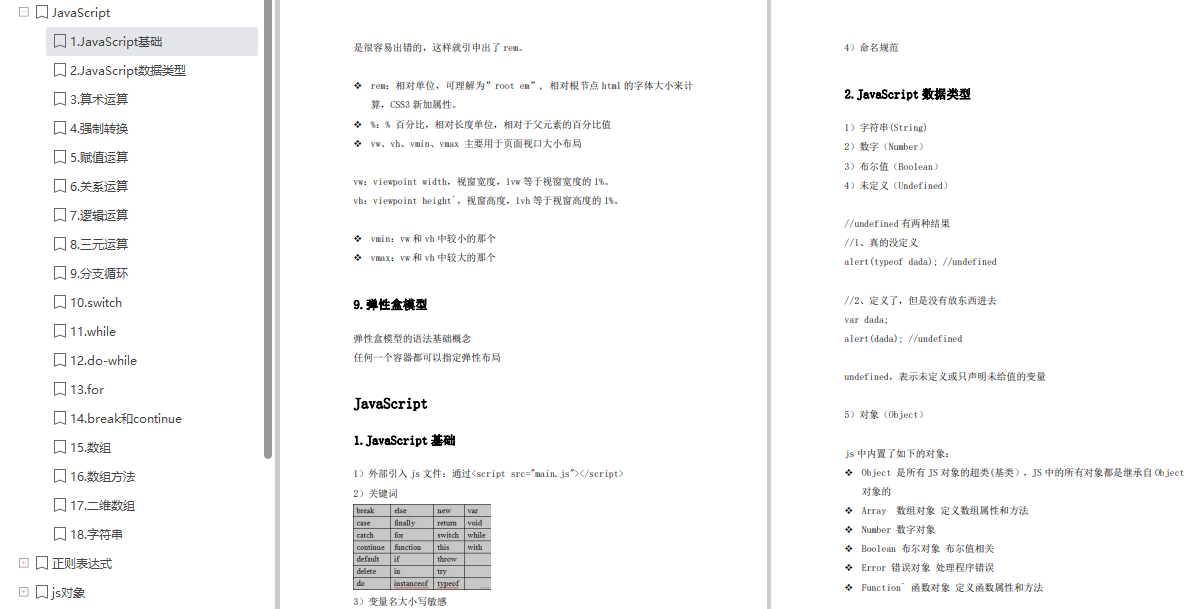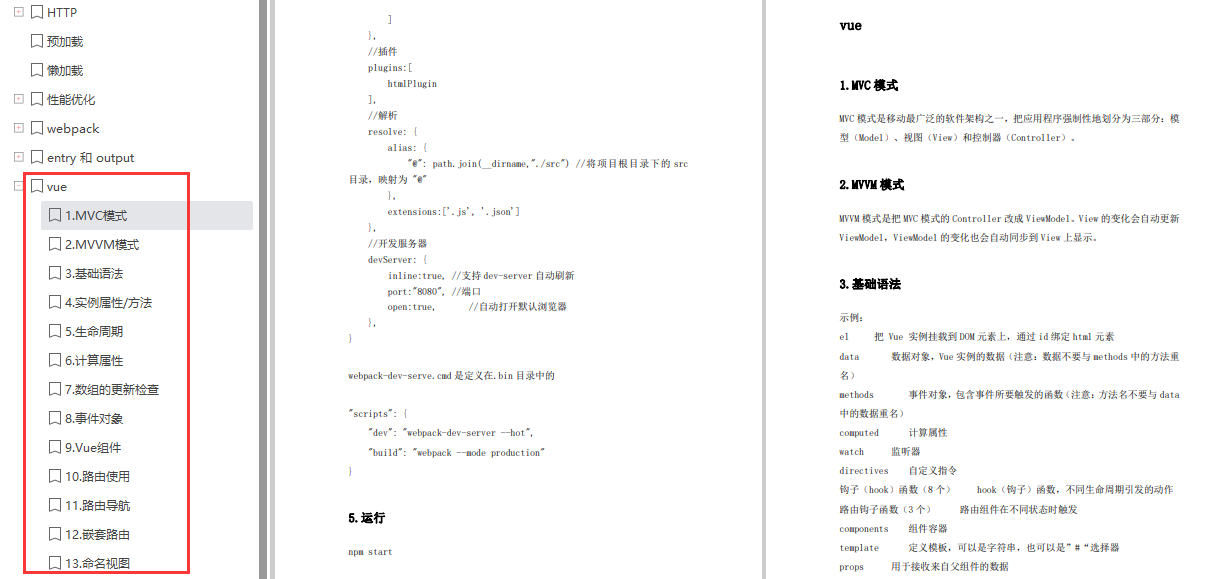学习分享,共勉
题外话,毕竟我工作多年,深知技术改革和创新的方向,Flutter作为跨平台开发技术、Flutter以其美观、快速、高效、开放等优势迅速俘获人心
开源分享:【大厂前端面试题解析+核心总结学习笔记+真实项目实战+最新讲解视频】

1 参考文档
参考1:基于 vite 创建 vue3 全家桶项目(vite + vue3 + tsx + pinia)
参考2:vite+vue3+ts 手把手教你创建一个vue3项目
2 所有步骤
- 创建vue3项目
- 配置src别名为@、src/components别名为@_c
- 安装less/scss
- 安装ESLint
- 安装Prettier
- 自动导入
- 安装router
- 安装pinia【vue-devtools插件、数据持久化插件 这两个先不装】
- 安装axios
- 自定义组件名setup语法糖
- 安装element-plus组件库
- 安装Ant Design Vue组件库【可选】
- 安装与使用Echarts
3 具体步骤
webstorm配置import/export代码有空格

3.1 创建vue3项目
NPM方式
npm create vite@latest
- 填写项目名称
- 选择前端框架【选Vue】
- 选择开发语言【TypeScript】
3.2 配置src别名为@、src/components别名为@_c
在vite配置src别名为@、src/components别名为@_c,这能在开发时对路径看些来直观点。
-
打开
vite.config.ts文件- 导入path模块
- 加入 解析配置
import { defineConfig } from 'vite'
import vue from '@vitejs/plugin-vue'
//1、 导入 path 模块,帮助我们解析路径
import { resolve } from 'path'
// https://vitejs.dev/config/
export default defineConfig({
plugins: [
vue(),
],
//1、 ↓解析配置
resolve: {
// ↓路径别名
alias: {
"@": resolve(__dirname, "./src"),
"\_c": resolve(__dirname, "./src/components")
}
}
})
- 打开
tsconfig.json文件
配置baseUrl,paths参数
{
"compilerOptions": {
"target": "ES2020",
"useDefineForClassFields": true,
"module": "ESNext",
"lib": [
"ES2020",
"DOM",
"DOM.Iterable"
],
"skipLibCheck": true,
/\* Bundler mode \*/
"moduleResolution": "bundler",
"allowImportingTsExtensions": true,
"resolveJsonModule": true,
"isolatedModules": true,
"noEmit": true,
"jsx": "preserve",
/\* Linting \*/
"strict": true,
"noUnusedLocals": true,
"noUnusedParameters": true,
"noFallthroughCasesInSwitch": true,
// 配置@别名 start
"baseUrl": ".",
"paths": {
"@/\*": [
"src/\*"
],
"\_c/\*": [
"src/components/\*"
]
}
// 配置@别名 end
},
"include": [
"src/\*\*/\*.ts",
"src/\*\*/\*.d.ts",
"src/\*\*/\*.tsx",
"src/\*\*/\*.vue"
],
"references": [
{
"path": "./tsconfig.node.json"
}
]
}
- 使用方式
重新运行一遍即可
3.3 安装less/scss
由于是使用vite,vite它提供了对 .scss, .sass, .less, .styl 和 .stylus 文件的内置支持,但必须安装相应的预处理器依赖;
国内一般只使用 less 或 scss,所以我只写这两个安装。
Sass、SCSS、Less介绍
Sass (Syntactically Awesome StyleSheets):后缀名为.sass,是由ruby语言编写的一款css预处理语言。
SCSS (Sassy CSS):后缀名为 .scss。SCSS 是 Sass 3 引入新的语法,与原来的语法兼容,只是用{ }替代了原来的缩进。SCSS语法完全兼容 CSS3,并且继承了 Sass 的强大功能。
Less:后缀名为 .less。与Sass类似,也是一款css预处理语言。与Sass不同的是,Less是基于Javascript,是在客户端处理的。Less 既可以在客户端上运行(支持IE 6+,Webkit,Firefox),也可以运行在 Node 服务端。
区别
- Scss功能较Less强大
1、scss有变量和作用域
2、scss有函数的概念
3、进程控制
4、数据结构 - Scss和Less处理机制不一样
1、前者是通过服务端处理的,后者是通过客户端处理,相比较之下前者解析会比后者快一点。 - Scss和Less在变量中的唯一区别就是Scss用$,Less用@
安装scss或less即可,只安装一个,如有需要再安装另一个。
- 安装scss依赖【优先推荐】
npm add -D scss
- 安装less依赖【推荐】
npm add -D less
- 安装sass 依赖【不推荐】
npm add -D sass
3.4 安装ESLint
ESLint主要用于代码规范、统一代码风格。因为校验严格,所以这个不是必要的功能。
- 安装ESLint依赖
npm install -D eslint
- ESLint的初始化
npm init @eslint/config
执行上述命令后,控制台中会有如下步骤:
1)需要安装 @eslint/create-config,问是否继续: 继续,直接回车;
2)使用ESLint来做什么:选最后一个 To check syntax, find problems, and enforce code style(检查语法、寻找问题、强制代码风格)
3)使用哪种模块化的方式:肯定选 JavaScript modules (import/export) (几乎我参与的 vue 项目都是 ESModule)
4)项目使用什么框架:Vue.js*
5)项目是否使用 TypeScript:Yes
6)项目运行在什么环境:Browser
7)如何定义项目的代码风格:Use a popular style guide 使用流行的风格
8)在流行的风格中选择其中一种:Standard
9)ESLint 配置文件的格式:JavaScript
10)根据上面选择的,提示需要安装一大堆依赖,是否安装?Yes
11)选择使用什么包管理工具安装:npm
接下来耐心等待安装依赖。
依赖安装完毕后,项目的根目录下会自动生成.eslintrc.cjs文件。
- 在package.json中配置,对代码进行校验和修复
在scripts下添加"lint:script": "eslint --ext .jsx,.vue,.tsx,.ts,.js --fix",完整代码:
{
"name": "vite-vue3-ts-project",
"private": true,
"version": "0.0.0",
"type": "module",
"scripts": {
"dev": "vite",
"build": "vue-tsc && vite build",
"preview": "vite preview",
"lint:script": "eslint --ext .jsx,.vue,.tsx,.ts,.js --fix"
},
"dependencies": {
"vue": "^3.3.4"
},
"devDependencies": {
"@typescript-eslint/eslint-plugin": "^6.7.2",
"@vitejs/plugin-vue": "^4.2.3",
"eslint": "^8.50.0",
"eslint-config-standard-with-typescript": "^39.1.0",
"eslint-plugin-import": "^2.28.1",
"eslint-plugin-n": "^16.1.0",
"eslint-plugin-promise": "^6.1.1",
"eslint-plugin-vue": "^9.17.0",
"scss": "^0.2.4",
"typescript": "^5.2.2",
"vite": "^4.4.5",
"vue-tsc": "^1.8.5"
}
}
- 在根目录下的.eslintrc.cjs中按如下配置添加
// eslint配置,用于校验代码
module.exports = {
// env指定环境 支持的环境: browser node commonjs es6 es2016~es2022...
// 环境很多,详情查看文档https://zh-hans.eslint.org/docs/latest/use/configure/language-options
"env": {
"browser": true,
"es2021": true,
"node": true,
},
// 使用插件配置
"extends": [
"eslint:recommended",
"plugin:vue/vue3-essential",
"plugin:@typescript-eslint/recommended"
],
// "overrides": [
// {
// "env": {
// "node": true
// },
// "files": [
// ".eslintrc.{js,cjs}"
// ],
// "parserOptions": {
// "sourceType": "script"
// }
// }
// ],
// 配置支持的js语言选项
"parserOptions": {
"ecmaVersion": "latest",
"sourceType": "module",
"parser": "@typescript-eslint/parser"
},
// eslint第三方插件配置
"plugins": [
"vue",
"@typescript-eslint"
],
// eslint规则配置,还有很多规则配置项,在官网查看 https://eslint.org/docs/latest/rules/
"rules": {
'@typescript-eslint/no-var-requires': 0, //解决报错:Require statement not part of import statement.
'vue/multi-word-component-names': 'off', //关闭组件命名规则校验
// => 前后有空格
"arrow-spacing": [
2,
{
before: true,
after: true,
},
],
"block-spacing": [2, "always"],
// 对象字面量项尾是否有逗号
"comma-dangle": [2, "always-multiline"],
}
}
- WebStorm配置ESLint【可选】

3.5 安装Prettier
prettier 是代码格式化工具,用它可以统一代码格式,风格。
- 安装Prettier依赖
npm install -D prettier
- 依赖安装完毕后,在项目的根目录下创建
.prettierrc.cjs配置文件,添加如下配置:
//.prettierrc.cjs
module.exports = {
printWidth: 80, //一行的字符数,如果超过会进行换行,默认为80
singleAttributePerLine: false, //每行强制换行,只能使用单个属性
tabWidth: 2, // 一个 tab 代表几个空格数,默认为 2 个
useTabs: false, //是否使用 tab 进行缩进,默认为false,表示用空格进行缩减
singleQuote: true, // 字符串是否使用单引号,默认为 false,使用双引号
semi: false, // 行尾是否添加分号,默认为true
trailingComma: 'none', //行使用逗号分隔 可选值: es5 none all
bracketSpacing: true, // 对象大括号直接是否有空格,默认为 true,效果:{ a: 1 }
endOfLine: 'auto', // 文本文件中的行结束方式 可选值: lf crlf cr auto
jsxBracketSameLine: false, // 在jsx中把'>' 是否单独放一行
vueIndentScriptAndStyle: false, // <script>Vue 文件中的代码和标签是否缩进<style>。
arrowParens: "always", // 箭头函数的括号
}
- 同时在根目录创建
.prettierignore文件用来忽略不需要Prettier格式化代码的文件
.DS_Store
node_modules
dist
/src/assets/\*
dist-ssr
\*\*/\*.svg
\*\*/\*.sh
- (没有冲突时可先不配置)
eslint和prettier的配置难免会有冲突,如果发生冲突,目前比较成熟的方案是使用以下两个插件:eslint-plugin-prettier: 基于prettier代码风格的eslint规则,即eslint使用pretter规则来格式化代码。eslint-config-prettier: 禁用所有与格式相关的eslint规则,解决prettier与eslint规则冲突,确保将其放在extends队列最后,这样它将覆盖其他配置。
npm install -D eslint-config-prettier eslint-plugin-prettier
安装完成后在.eslintrc.cjs文件中extends的最后添加一个配置
// 使用插件配置
"extends": [
"eslint:recommended",
"plugin:vue/vue3-essential",
"plugin:@typescript-eslint/recommended",
"plugin:prettier/recommended" // 新增,必须放在最后面
],
3.6 自动导入
- 安装
npm install -D unplugin-vue-components unplugin-auto-import
vite.config.ts引入配置
import { defineConfig } from 'vite'
import vue from '@vitejs/plugin-vue'
//1、 导入 path 模块,帮助我们解析路径
import { resolve } from 'path'
//2-1 自动导入vue中hook reactive ref等
import AutoImport from 'unplugin-auto-import/vite'
//2-2 自动导入ui-组件 比如说ant-design-vue element-plus等
import Components from 'unplugin-vue-components/vite'
// https://vitejs.dev/config/
export default defineConfig({
plugins: [
vue(),
AutoImport({
//安装两行后你会发现在组件中不用再导入ref,reactive等
imports: ['vue', 'vue-router'],
//存放的位置
dts: "src/auto-import.d.ts",
}),
Components({
// 引入组件的,包括自定义组件,存放的位置
dts: "src/components.d.ts",
}),
],
//1、 ↓解析配置
resolve: {
// ↓路径别名
alias: {
"@": resolve(__dirname, "./src"),
"\_c": resolve(__dirname, "./src/components")
}
}
})
- components.d.ts配置(仅供参考)
/\* eslint-disable \*/
/\* prettier-ignore \*/
// @ts-nocheck
// Generated by unplugin-vue-components
// Read more: https://github.com/vuejs/core/pull/3399
export {}
declare module 'vue' {
export interface GlobalComponents {
HelloWorld: typeof import('./components/HelloWorld.vue')['default']
RouterLink: typeof import('vue-router')['RouterLink']
RouterView: typeof import('vue-router')['RouterView']
}
}
- auto-import.d.ts配置(仅供参考)
/\* eslint-disable \*/
/\* prettier-ignore \*/
// @ts-nocheck
// noinspection JSUnusedGlobalSymbols
// Generated by unplugin-auto-import
export {}
declare global {
const EffectScope: typeof import('vue')['EffectScope']
const computed: typeof import('vue')['computed']
const createApp: typeof import('vue')['createApp']
const customRef: typeof import('vue')['customRef']
const defineAsyncComponent: typeof import('vue')['defineAsyncComponent']
const defineComponent: typeof import('vue')['defineComponent']
const effectScope: typeof import('vue')['effectScope']
const getCurrentInstance: typeof import('vue')['getCurrentInstance']
const getCurrentScope: typeof import('vue')['getCurrentScope']
const h: typeof import('vue')['h']
const inject: typeof import('vue')['inject']
const isProxy: typeof import('vue')['isProxy']
const isReactive: typeof import('vue')['isReactive']
const isReadonly: typeof import('vue')['isReadonly']
const isRef: typeof import('vue')['isRef']
const markRaw: typeof import('vue')['markRaw']
const nextTick: typeof import('vue')['nextTick']
const onActivated: typeof import('vue')['onActivated']
const onBeforeMount: typeof import('vue')['onBeforeMount']
const onBeforeRouteLeave: typeof import('vue-router')['onBeforeRouteLeave']
const onBeforeRouteUpdate: typeof import('vue-router')['onBeforeRouteUpdate']
const onBeforeUnmount: typeof import('vue')['onBeforeUnmount']
const onBeforeUpdate: typeof import('vue')['onBeforeUpdate']
const onDeactivated: typeof import('vue')['onDeactivated']
const onErrorCaptured: typeof import('vue')['onErrorCaptured']
const onMounted: typeof import('vue')['onMounted']
const onRenderTracked: typeof import('vue')['onRenderTracked']
const onRenderTriggered: typeof import('vue')['onRenderTriggered']
const onScopeDispose: typeof import('vue')['onScopeDispose']
const onServerPrefetch: typeof import('vue')['onServerPrefetch']
const onUnmounted: typeof import('vue')['onUnmounted']
const onUpdated: typeof import('vue')['onUpdated']
const provide: typeof import('vue')['provide']
const reactive: typeof import('vue')['reactive']
const readonly: typeof import('vue')['readonly']
const ref: typeof import('vue')['ref']
const resolveComponent: typeof import('vue')['resolveComponent']
const shallowReactive: typeof import('vue')['shallowReactive']
const shallowReadonly: typeof import('vue')['shallowReadonly']
const shallowRef: typeof import('vue')['shallowRef']
const toRaw: typeof import('vue')['toRaw']
const toRef: typeof import('vue')['toRef']
const toRefs: typeof import('vue')['toRefs']
const toValue: typeof import('vue')['toValue']
const triggerRef: typeof import('vue')['triggerRef']
const unref: typeof import('vue')['unref']
const useAttrs: typeof import('vue')['useAttrs']
const useCssModule: typeof import('vue')['useCssModule']
const useCssVars: typeof import('vue')['useCssVars']
const useLink: typeof import('vue-router')['useLink']
const useRoute: typeof import('vue-router')['useRoute']
const useRouter: typeof import('vue-router')['useRouter']
const useSlots: typeof import('vue')['useSlots']
const watch: typeof import('vue')['watch']
const watchEffect: typeof import('vue')['watchEffect']
const watchPostEffect: typeof import('vue')['watchPostEffect']
const watchSyncEffect: typeof import('vue')['watchSyncEffect']
}
// for type re-export
declare global {
// @ts-ignore
export type {
Component,
ComponentPublicInstance,
ComputedRef,
InjectionKey,
PropType,
Ref,
VNode,
WritableComputedRef
} from 'vue'
}
3.7 安装配置router
- npm方式
npm install vue-router@4
-
配置步骤
- 创建测试页面
views/about/index.vue
- 创建测试页面
<template>
<div>
<h1>About Page</h1>
</div>
</template>
<script>
export default {
name: "index"
}
</script>
<style scoped>
</style>
* `views/home/index.vue`
<template>
<div>
<h1>Home Page</h1>
</div>
</template>
<script>
export default {
name: "index"
}
</script>
<style scoped>
</style>
2. 配置路由,在`src`下创建一个`router`文件夹,再创建一个`index.ts`文件
**注意**:必须要有`path`为`"/"`的路由,否则浏览器控制台报`No match found for location with path "/"`
import { createRouter, createWebHistory } from "vue-router"
const routes = [
{
path: '/',
redirect: 'index',
},
{
path: '/index',
name: 'Home',
component: () => import('@/views/home/index.vue')
},
{
path: '/about',
name: 'About',
//使用import可以路由懒加载,如果不使用,太多组件一起加载会造成白屏
component: () => import('@/views/about/index.vue')
},
//{
//配置404页面
//path: '/:catchAll(.\*)',
//name: '404',
//component: () => import(''),
//}
]
// 路由
const router = createRouter({
history: createWebHistory(),
routes
})
// 导出
export default router
- 在src的
main.ts文件引入。
import { createApp } from 'vue'
import './style.css'
import App from './App.vue'
//1、route
import router from '@/router/index'
const app = createApp(App)
//1、route
app.use(router)
app.mount('#app')
- App.vue使用路由
<script setup lang="ts">
</script>
<template>
<!-- 路由跳转-->
<router-link to="/">首页</router-link>
<br>
<router-link to="/about">关于</router-link>
<router-view></router-view>
</template>
<style scoped>
</style>
3.8 安装Pinia
参考1:Vue3 Vite3 状态管理 pinia 基本使用、持久化、在路由守卫中的使用
因为是vue3+ts,安装Pinia更好点,vuex拥抱ts没有Pinia好。
Pinia介绍
参考:什么是Pinia?
Pinia和Vuex一样都是是vue的全局状态管理器。其实Pinia就是Vuex5,只不过为了尊重原作者的贡献就沿用了这个看起来很甜的名字Pinia。
3.8.1 Pinia的使用
- npm方式安装
npm install pinia
- 在src下创建一个
store文件夹,再创建一个index.ts文件
其它名也可以,因为
pinia它有一个根文件,会把createPinia第一个参数当id值,相当于vuex中的module自动引入,也会在Vue.js devtools插件中以第一个参数名展示(下面展示)
注意:createPinia第一个参数很重要,而且是唯一值。它的命名在devtools插件能方便找到这个文件的数据,方便调试。
import { createPinia } from 'pinia'
const pinia = createPinia()
export default pinia
- 在
src的main.ts引入
import { createApp } from 'vue'
import './style.css'
import App from './App.vue'
//1、route
import router from '@/router/index'
//2、pinia
import pinia from '@/store'
const app = createApp(App)
//1、route
app.use(router)
//2、pinia
app.use(pinia)
app.mount('#app')
- 在
store文件夹下创建modules目录,存储每个模块的状态,新建demo.ts。这里使用最新的Composition APIsetup的方式来定义状态。
import { defineStore } from 'pinia'
import { ref } from 'vue'
const useDemoStore = defineStore('demo', () => {
const counter = ref(0)
const increment = () => {
counter.value++
}
return {
counter,
increment
}
})
export default useDemoStore
- 使用
pinia
在路由示例的about.vue页面使用!
<template>
<div>
<h1>About Page</h1>
<h3>counter: {{ counter }}</h3>
<button @click="add">计数</button>
</div>
</template>
<script setup lang="ts">
import useDemoStore from '@/store/modules/demo'
import { storeToRefs } from 'pinia'
const demoStore = useDemoStore()
const {counter} = storeToRefs(demoStore)
const add = () => {
demoStore.increment()
}
</script>
<style scoped>
button {
color: cornflowerblue;
font-size: 30px;
}
</style>
3.8.2 Pinia状态持久化
在3.7.1中,假设计数器加到5,如果刷新浏览器,counter的值又会被初始化为0。这是因为状态是存储在浏览器内存中的,刷新浏览器后,重新加载页面时会重新初始化vue、pinia,而pinia中状态的值仅在内存中存在,而刷新导致浏览器存储中的数据没了,所以counter的值就被初始化为0。
要解决这个问题非常简单,在状态改变时将其同步到浏览器的存储中,如cookie、localStorage、sessionStorage。每次初始化状态时从存储中去获取初始值即可。
使用pinia的插件pinia-plugin-persistedstate来实现。
- 安装依赖
npm install pinia-plugin-persistedstate
- 引入该插件,在src的store文件夹下修改index.ts文件:
import { createPinia } from 'pinia'
import piniaPluginPersistedstate from 'pinia-plugin-persistedstate'
const pinia = createPinia()
pinia.use(piniaPluginPersistedstate)
export default pinia
- 设置
persist持久化
在需要持久化状态的模块中设置persist。假设demo模块需要对状态需要持久化,defineStore第一个参数定义唯一的模块名,第二个参数传递setup,其实还有第三个参数options,在options中便可开启持久化:
修改store/modules/demo.ts:
import { defineStore } from 'pinia'
import { ref } from 'vue'
const useDemoStore = defineStore('demo', () => {
const counter = ref(0)
const increment = () => {
counter.value++
}
return {
counter,
increment
}
}, {
persist: true
})
export default useDemoStore
会将状态缓存在localStorage中。
4. 如果需要将其存储在sessionStorage中,就需要设置persist的值为一个对象:
import { defineStore } from 'pinia'
import { ref } from 'vue'
const useDemoStore = defineStore('demo', () => {
const counter = ref(0)
const increment = () => {
counter.value++
}
return {
counter,
increment
}
}, {
persist: {
key: 'aaa',
storage: sessionStorage
}
})
export default useDemoStore
3.9 安装配置axios
- npm方式安装
npm install axios
- 封装request
在src下创建一个utils文件夹,添加request.ts文件
import axios from 'axios'
// 创建axios实例
const request = axios.create({
baseURL: '',// 所有的请求地址前缀部分(没有后端请求不用写)
timeout: 80000, // 请求超时时间(毫秒)
withCredentials: true,// 异步请求携带cookie
// headers: {
// 设置后端需要的传参类型
// 'Content-Type': 'application/json',
// 'token': x-auth-token',//一开始就要token
// 'X-Requested-With': 'XMLHttpRequest',
// },
})
// request拦截器
request.interceptors.request.use(
config => {
// 如果你要去localStor获取token
let token = localStorage.getItem("x-auth-token");
if (token) {
//添加请求头
config.headers["Authorization"] = "Bearer " + token
}
return config
},
error => {
// 对请求错误做些什么
Promise.reject(error)
}
)
// response 拦截器
request.interceptors.response.use(
response => {
// 对响应数据做点什么
return response.data
},
error => {
// 对响应错误做点什么
return Promise.reject(error)
}
)
export default request
- 创建调用的接口
在src下创建一个api文件夹,然后再在api下创建login文件夹,添加login.ts文件
定义接口格式:
export const 自定义接口名 = (形参:请求类型):返回类型 => instance.方法(路径,后端要的参数);
import instance from "@/utils/request";
//一般情况下,接口类型会放到一个文件
// 下面两个TS接口,表示要传的参数
interface ReqLogin {
name: string
paw: string
}
interface ReqStatus {
id: string
navStatus: string
}
// Res是返回的参数,T是泛型,需要自己定义,返回对数统一管理\*\*\*
type Res<T> = Promise<ItypeAPI<T>>;
// 一般情况下响应数据返回的这三个参数,
// 但不排除后端返回其它的可能性,
interface ItypeAPI<T> {
data: T,//请求的数据,用泛型
msg: string | null // 返回状态码的信息,如请求成功等
code: number //返回后端自定义的200,404,500这种状态码
}
// post请求 ,没参数
export const LogoutAPI = (): Res<null> => instance.post("/admin/logout");
// post请求,有参数,如传用户名和密码
export const loginAPI = (data: ReqLogin): Res<string> =>
instance.post("/admin/login", data);
// post请求 ,没参数,但要路径传参
export const StatusAPI = (data: ReqStatus): Res<null> =>
instance.post(`/productCategory?ids=${data.id}&navStatus=${data.navStatus}`);
// get请求,没参数,
export const FlashSessionListApi = (): Res<null> =>
### 总结
根据路线图上的重点去进行有针对性的学习,在学习过程中,学会写笔记,做总结。
**[开源分享:【大厂前端面试题解析+核心总结学习笔记+真实项目实战+最新讲解视频】](https://bbs.csdn.net/forums/4304bb5a486d4c3ab8389e65ecb71ac0)**
这里分享一些前端学习笔记:
* **html5 / css3 学习笔记**

* **JavaScript 学习笔记**

* **Vue 学习笔记**

的这三个参数,
// 但不排除后端返回其它的可能性,
interface ItypeAPI<T> {
data: T,//请求的数据,用泛型
msg: string | null // 返回状态码的信息,如请求成功等
code: number //返回后端自定义的200,404,500这种状态码
}
// post请求 ,没参数
export const LogoutAPI = (): Res<null> => instance.post("/admin/logout");
// post请求,有参数,如传用户名和密码
export const loginAPI = (data: ReqLogin): Res<string> =>
instance.post("/admin/login", data);
// post请求 ,没参数,但要路径传参
export const StatusAPI = (data: ReqStatus): Res<null> =>
instance.post(`/productCategory?ids=${data.id}&navStatus=${data.navStatus}`);
// get请求,没参数,
export const FlashSessionListApi = (): Res<null> =>
### 总结
根据路线图上的重点去进行有针对性的学习,在学习过程中,学会写笔记,做总结。
**[开源分享:【大厂前端面试题解析+核心总结学习笔记+真实项目实战+最新讲解视频】](https://bbs.csdn.net/forums/4304bb5a486d4c3ab8389e65ecb71ac0)**
这里分享一些前端学习笔记:
* **html5 / css3 学习笔记**

* **JavaScript 学习笔记**

* **Vue 学习笔记**

























 2062
2062

 被折叠的 条评论
为什么被折叠?
被折叠的 条评论
为什么被折叠?








